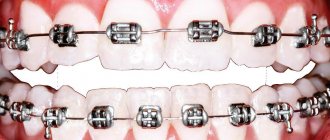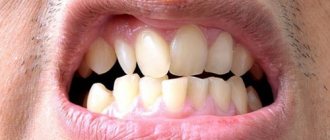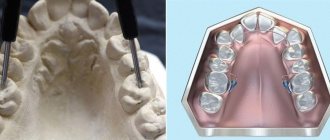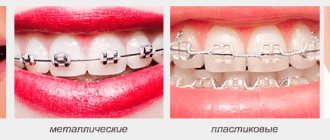Fernand Joseph Contandin - owner of the largest teeth in the world
At the moment, the actor, who went down in cinematic history under the nickname Fernandel, is considered the man with the largest and longest teeth in the world.
It cannot be said that it was his teeth that helped Fernandel become famous. However, the actor became famous throughout the world, received the Legion of Honor award and was named one of the most outstanding citizens of France, earning great respect from the public. It is believed that Fernandel can be recognized by his teeth. Just like Charlie Chaplin, by the mustache. The audience especially enjoyed those moments when the actor whistled loudly.
What symptoms indicate that fangs are cutting?
Signs of the impending appearance of fangs appear in babies long before the moment when these teeth appear from the gums. Usually, symptoms of their appearance are encountered 2-4 weeks before tooth eruption , but there are often situations when the fangs begin to bother the baby even earlier.
In a child with teething teeth, parents will notice:
- Bad mood, irritability and moodiness.
- Excessive production of saliva , which can cause a cough or runny nose.
- Swollen and discolored gums in areas where the fang is expected. They turn red and become more prominent, after which a new tooth appears under the gum in the form of a white dot.
- Decreased appetite, and sometimes refusal to eat.
- Restless sleep , disturbed by soreness and burning in the gums.
- The desire to gnaw and chew on various objects so that they scratch the gums.
Read also: At what age should a child get braces?
A pediatrician of the highest category, Mikhailova T.M., tells more about the symptoms.
Such symptoms are observed in many babies, but when fangs erupt, they are often accompanied by more unpleasant signs, including:
- Temperature rises to +37.5+38°C (less often up to +39°C) within 1-3 days.
- Loose stool , caused by excess saliva swallowed by the baby.
- Strengthening the gag reflex , which is also associated with a large amount of saliva in the toddler’s mouth.
- Rash on the chin due to the irritating effects of saliva.
Interesting facts about human teeth
It is not difficult to guess that Hollywood stars use expensive dental services to ensure the best dental condition and give the public an excellent smile. However, we must never forget that our teeth are a valuable gift of nature, and they have their own characteristics.
It is now known that tooth enamel is the strongest tissue in the human body. High hardness of tooth enamel is necessary in order to cope with a wide variety of foods. All people have unique sets of teeth. It doesn't matter how big or small they are. This is due not only to genetics, but also to lifestyle features. A large volume of saliva accumulates in the oral cavity every day. Up to one and a half liters per day. This is necessary to protect teeth from bacteria, additional cleaning of enamel, etc.
How human teeth evolved
There is not a single person in the modern world who could surpass the size of teeth of those people who lived approximately 100 thousand years ago. Our ancestors had very large and long teeth, because they needed to eat rough plant foods and raw meat. The digestive system was also different, but it adapted to the corresponding reality. Anthropologists have calculated that human teeth have been steadily shrinking since then—by about 0.95% in each era.
While studying the remains of the skulls of ancient people, scientists noticed that they had large and long fangs that allowed them to hold food. Currently, the largest and longest tooth is the first molar, located on the upper jaw.
Can large and long teeth be considered a pathology?
Long teeth cannot be called a pathology if they grow normally. There are many examples in the world of people who have large teeth, but they have no problems in everyday life. The most striking examples are the inhabitants of island states. Some of them have very powerful jaws, with which they can easily cut through plant food and even peel the fruits of exotic trees.
The problem with large and long teeth begins the moment twisting occurs. Due to the developing malocclusion, a person begins to experience discomfort, and his smile loses its aesthetics. The bite is important for the digestive system, so it should be taken care of. All over the world, doctors recommend monitoring the condition of your teeth, not only by using toothpaste, but also by performing a dental examination in front of a mirror. Because of large teeth, people often experience communication problems.
Teething process
Sometimes children are born with a tooth already grown, and in other cases, the first teeth may not appear until about a year old. And even the order in which teeth erupt does not always remain the same. Often parents, having noticed drooling in children, which begins at approximately 3-4 months, and sometimes earlier, regard this as the first sign of teething. But in fact, the increase in drooling is due to the beginning of more intensive functioning of the salivary glands, which in infants work very little. At this time, babies are not yet very good at swallowing, which is why they drool.
The period of teething in the baby. The main thing is to reduce pain and itching of the gums.
The very first sign of the beginning of teething is the appearance of a whitish spot on the lower gum or swelling on its leading edge. Often this is accompanied by increased drooling, a desire to bite toys, fingers and any other objects, as well as irritability, restless sleep and lack of appetite.
Of course, most parents are concerned with the question of whether they can help their child or whether they are not recommended to interfere with the natural course of events, but to let them go their own way. Doctors recommend allowing teeth to erupt on their own and not using any external force to cut through them. You should not irritate the baby’s gums by scratching them strongly with any objects, as was previously customary, since this can not only harm fragile baby teeth, but even introduce some kind of infection into the jawbone.
How to distinguish big teeth
There are certain standards for the teeth of Europeans. It is determined in the world that the norm for the length of the upper incisors should be a maximum of 13 mm, for the lateral ones it is approximately 2 mm shorter. If the norm is exceeded by one and a half times, then it is customary to diagnose macrodentia.
Long teeth can be corrected. The most common method is grinding. Sometimes it cannot be resorted to, so correction followed by restoration is used. If the reason your teeth appear large is due to an incorrect bite, braces are used. The fashion world's beauty standards are often surprising, so it's normal for people with big, long teeth to gain a lot of publicity. Some of the most famous Hollywood stars, such as Julia Roberts and Anne Hathaway, have very interesting smiles. Therefore, deviation from the norm cannot always be considered something bad. If the teeth do not interfere, then they can be left as nature intended them. There are a number of famous actors who consider their large and long teeth to be a gift.
- Brigitte Bardot is one of them. She was considered a real ugly duckling, because she not only had an incorrect bite, but also the most unattractive appearance in the class. The girl's lower lip was protruding and she had a squint. Gradually, the strabismus was overcome, and Brigitte decided to leave the malocclusion. This made her incredibly popular all over the world.
- Amy Winehouse was also a singer who was not at all bothered by large teeth. Emmy's front incisors seem huge, so her smile was perceived ambiguously by the public. But the British performer loved to smile widely. Amy Winehouse loved to test her strength by smoking cigarettes and drinking alcohol. And yet, at one fine moment, the girl thought about the health of her oral cavity and put her teeth in order.
- Keira Knightley is considered one of the most popular film actresses around the world. The actress has large incisors, and she has never tried to change her smile. On the contrary, Knightley became a fan of her own bite and showed it to the whole world without being at all embarrassed. In Hollywood, the actress is considered one of the best, so no one pays attention to Knightley’s large incisors or bite.
- Benedict Cumberbatch is another actor whom nature decided not to bestow with a beautiful smile. But he is considered one of the most popular actors in the world of the last decade. Having starred in the TV series Sherlock, he was able to win a huge audience thanks to his charisma. His smile is often compared to a crooked picket fence, his long incisors seem scary, but this does not stop Benedict from starring in films and TV series. He is a truly charismatic person, so he easily wins people over.
- Katy Perry has a very interesting take on her own smile. The world knows her as one of the most popular singers, but Katy Perry herself is not very happy with the way her teeth look. Having gained great popularity, the girl still believes that she was unlucky with her smile. However, she does not want to change what nature has given her. Katy Perry is known for her original look at her appearance, so she is not afraid to change her hair color, dyeing her hair green and even purple.
How children's fangs erupt
The timing of teething is strictly individual for each baby. Sometimes babies delight their parents with a grown tooth already at 4-5 months, while in other children the first tooth appears only at 8-9 months. Doctors usually explain to worried parents that there is no norm for this time, and sometimes even the usual order of teething changes. There are only standard dates that approximately determine the time of teething.
So, at 6-9 months, infants grow their lower central incisors, and a little later, their upper incisors. After this, about a year later, the lateral incisors erupt on both jaws.
What symptoms accompany teething in a child?
At 12-15 months, molars begin to emerge from above and below. And only at 16-22 months the upper canines begin to grow. It is precisely because of the presence of the optic nerve nearby that when a child’s fangs emerge, the symptoms of this are often complicated by lacrimation. If we consider that one of the functions of the optic nerve is to provide communication between the central nervous system and the upper half of the face, then we can easily explain that when a child’s fangs are cut, the symptoms of this process can be excruciating and painful for the baby, and as a result, for him. parents.
What to eat to strengthen your teeth
Taking care of your oral cavity requires more than just a toothbrush. Nutrition plays an important role. It is no coincidence that doctors recommend giving up sugar, since bacteria that live in the mouth convert substances into acid, which negatively affects tooth enamel.
Unfortunately, many products contain sugar or sweeteners, so you won’t be able to avoid trouble. The best products for teeth are:
- cheese;
- chicken;
- meat;
- nuts;
- milk.
It is thanks to them that the enamel can be protected, as they contain important substances, including calcium and phosphorus. Calcium is practically the most important element. It is found in large quantities in fish, beets, legumes, nuts (almonds), and grapes. In Arab countries, they prefer to consume honey, and this is good for the teeth, since such a delicacy contains a lot of calcium. You can also resort to using medications. There are even some that contain calcium in combination with vitamin D.
The vitamin promotes better absorption of the substance, although it can be obtained from foods such as liver. A large amount of vitamin D contains fish oil, which is sold in any pharmacy.
Fluoride is no less important. It is he who is responsible for protecting the enamel. Thanks to fluoride, acid-resistant compounds are formed that prevent the formation of caries. It is best to buy fluoridated water, as this is the easiest way to provide the body with enough of this substance. Dairy products containing fluoride are sold on supermarket shelves. You can also buy fluoridated salt.
Diet is important for a person. It is better to choose products whose dietary fiber is quite coarse. Various dried fruits may be a good option to replace the usual sweets, but due to their high sugar content they negatively affect tooth enamel. Sweet carbonated drinks are harmful, the same goes for tea with sugar or coffee. To minimize the harmful effects of sugar, you can chew gum and brush your teeth 3 times a day.
At what age does a child start to have fangs?
Nature has endowed humans with four fangs, located in pairs in the lower and upper dentitions. In dentistry, this type of teeth is called a triple, since their location is the area between the lateral incisors (second from the center of the row) and the first molars (fourth in a row).
Eruption of canines begins in children aged 16–18 months. By this time, the baby’s mouth already has 12 milk teeth: 4 central and lateral incisors and 2 molars on the lower and upper rows.
The canines are cut unevenly: the upper ones appear earlier - from 16 to 22 months, the lower ones a little later - from 17 to 23 months. However, standards in dentistry are a relative concept. It often happens that the “schedule” shifts to one side; in rare cases, the order of eruption of different types of teeth may be confused. The timing and sequence of eruption depend on the individual characteristics of the body: heredity, the nature of mineral metabolism, the degree of calcium absorption.
What affects the timing of teeth appearance?
Children often develop fangs at a different age from the norm; the period of their eruption is greatly influenced by the intrauterine period of development:
- how the formation and formation of tooth germs took place;
- how complete the mother’s nutrition was;
- woman's age;
- How did the pregnancy proceed?
Teeth formation continues after the baby is born, therefore:
- It is desirable that breastfeeding of newborns last for at least 6 months, ideally up to 9 months;
- The diet of a nursing woman should include a sufficient amount of milk and dairy products, fish and seafood, and mineral-rich vegetables;
- With the approval of a doctor, you can take vitamin and mineral complexes.
Read also: Baby teething schedule
Also, the time at which a child grows a full set of teeth is influenced by climate and geographic zone of residence.
Why are teeth “delayed”?
If we exclude hereditary causes, then the problem of late teething may lie in insufficient intake of nutrients into the body and metabolic disorders. Most likely, the child’s body lacks minerals and vitamin D, which affects the absorption of calcium.
Adentia can lead to dental problems. A rather rare disease is a consequence of a disorder of intrauterine development, in which the rudiments of teeth do not form. This problem can be solved only in one way - with the help of implantation.
What diet should you choose for your teeth?
It is necessary to monitor your carbohydrate intake. If you really want something sweet, it is better to choose honey, since it does not form a persistent film on the surface. Modern sweeteners are substances that are quite aggressive towards tooth enamel. Natural honey has minimal impact on the enamel.
You should include plant fiber in your food, as it helps to better clean your teeth and strengthen your gums, so you should minimize the consumption of freshly squeezed juices or grated fruits (vegetables). Coarse fiber is needed for teeth.
Acidic foods help improve salivation. It can be fruits, cabbage, broths, vegetables. You should not exclude seaweed from your diet. Saliva has anti-caries properties, washing away bacteria; moreover, it contains lysozyme, which strengthens tooth enamel.
So what to do? It may seem that it is necessary to give up many of the pleasures of life. Sweets are an antidepressant and promote the production of endorphins. Of course, you don’t need to deny yourself the consumption of sweets, but try to keep it in moderation and choose ones that contain a minimum of sugar. You can simply brush your teeth regularly for at least 3 minutes and use chewing gum after meals, chewing it thoroughly for about 10 minutes.
Is it true that teething is the most painful part?
The appearance of fangs is indeed the most difficult and uncomfortable process for children, which is associated with the anatomical features and location of these teeth. Their roots are quite long and go deep into the gums. In addition, the upper canines are located close to the facial nerves, which is why they are called “eye” teeth. When cutting through this pair of teeth, in addition to the usual characteristic symptoms, the child may experience lacrimation and other signs of conjunctivitis.
The eruption of fangs on the lower jaw is not so painful, so such teeth bother babies less, however, parents should be prepared for an increase in temperature for up to 3 days, and short-term upset bowel movements, and other “dental” symptoms that worsen the well-being and mood of the little one .









